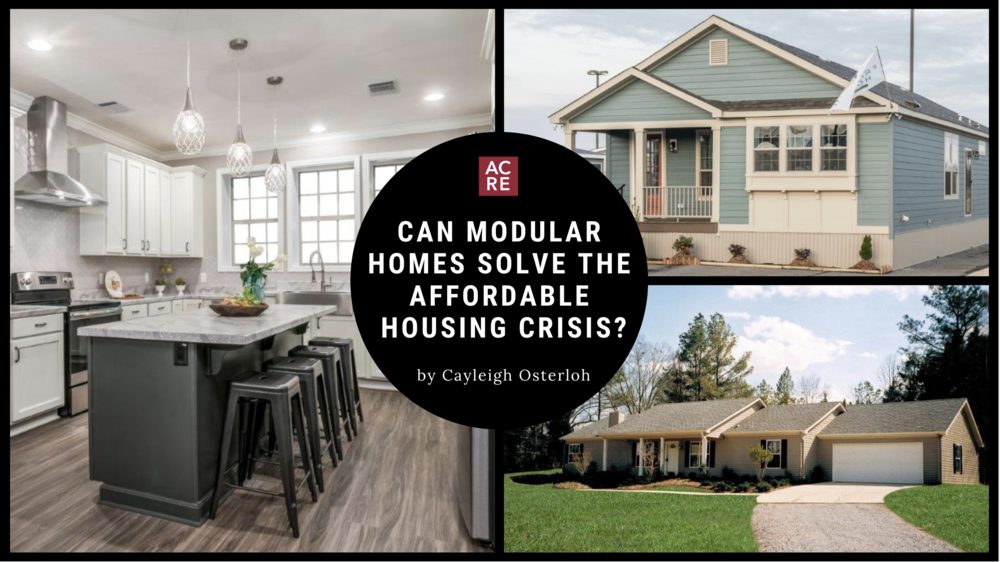When compared to the national housing market, Alabama’s housing market is more affordable with a higher index score[1] of over 48 percent, however, that doesn’t quite tell the whole story. The Alabama Housing Affordability Index has decreased by 12.9 percent from the first quarter of 2018. This decrease is attributed to rising rates and increases in the statewide median sales price. A total of 12 markets in the Metro Area group in Alabama experienced a decrease in affordability from last quarter, with Birmingham showing the largest decrease at 12.32 percent. The Non-Metro Areas follow the same pattern, with 5 out of the 6 markets showing a decrease in affordability. How might Alabama keep its affordability rates from declining in the future? One part of the solution may not be all that difficult.
Historically, modular homes carried an unfavorable connotation due to stereotypes created by society. However, with advances in design and construction, modular homes are becoming a beautifully-designed, energy-efficient, affordable option for housing.
The prospect of modular homes being a solution to affordable housing is an idea that Boo Haughton of Franklin Homes can firmly stand by. “Rent is very high. This is what we’re hearing from the general housing market,” Haughton states. “It’s a great alternative, so that people can be a homeowner for less money a month.”
Currently, over 12 million Americans pay over 50 percent of their yearly income for housing. The U.S. Department of Housing and Urban Development identifies familes as cost-burdened when they “pay more than 30 percent of their income for housing” and “may have difficulty affording necessities such as food, clothing, transportation and medical care.”
As a modular home manufacturing company, Franklin Homes takes these statistics into account, and works to provide affordable homes that are built with the highest quality. “People can get high-quality products on the ground probably with higher quality than they could build, for less money,” expresses Haughton.
Compared to site-built homes, buyers spend about 40.5 percent less on modular homes in the same area. These individuals purchasing modular homes aren’t solely based in rural locations; the modular home industry has begun to witness the spread of modular homes into urban cities due to industry efforts to showcase the overall enhancement of product quality.
However, even with the increased need for cheaper housing, modular homes are seldom considered an answer to the lack of affordable housing.
“There are some limitations, but the bottom line is you can get it (modular home) in a shorter period of time from start to finish with the same materials,” stated Haughton.
The current modifications being made in construction and design can reveal the possibility for modular homes to be a solution to affordable housing.
“Contractors are coming to us to help them out, because their labor force is non-existent. They’re having trouble with skilled labor,” stated Haughton. The labor shortages being experienced in the construction industry are reducing the total construction of on-site homes. In comparison, modular homes are constructed in factories, instead of on-site and thus cost less to construct.
Modular homes create affordable housing opportunities for people with low incomes due to the lower rent and prices. The government is becoming aware of these advantages as the banks have begun to approve more modular home loans. “We think it’s great. It lets us know that the finance world – when I say that, I mean banks and insurance – are taking our industry a little more serious, and we’re thankful that they’re showing that favor to us,” expressed Haughton.
The continued increase and need for affordable housing for those households with low incomes could possibly be solved through the quicker and cheaper manufacturing of modular homes. While there has been an increase in modular homes located in city areas, they ultimately offer more solutions to affordable housing in rural areas. With the perpetual modernization and rejuvenation of the modular home industry, the industry is emerging as a viable solution to affordable housing.
__
[1] calculation of the ratio of the state’s actual median family income to the income needed to purchase and finance the state’s median-priced home.
The Alabama Center for Real Estate publishes an Alabama Housing Affordability Index quarterly. View the Q3 2018 index here.





